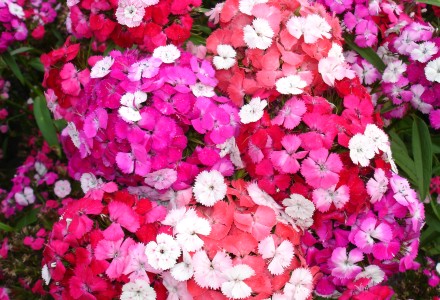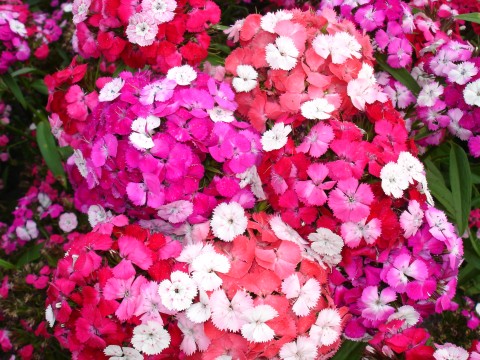When the flowers of 'Noverna Clown' open, they are white, but growing on they change to pink, salmon or violet, making this first year flowering Dianthus a true Gold Medal winner. Flowering starts in the spring and continues well into the autumn. The fact that the plants are fairly frost tolerant saves them from the dreaded night frost in the early flowering season. Given the chance, 'Noverna Clown' will form a plant with a height of 40 cm. This makes it both excellent for pot and garden performance.
IN DETAIL
Dianthus barbatus F1 'Noverna Clown' is part of the Noverna series. 'Noverna Purple' which is from the same series, was awarded a Gold Medal previously in 2002 because of the fact that this Sweet William did not require vernalization. The new Gold Medal winner shares this characteristic and goes through a clownish colour change. The flowers start out white but gradually changes colour to salmon, pink or violet. Novernas continue to flower well into autumn. They even endure some night frost. This makes this series, including 'Noverna Clown' suitable for the autumn trade. If sown in June for example, the flowering plants can be found in the garden centres in late summer. Sown in the autumn, the plants can be sold early in spring. 'Noverna Clown' does not immediately give in at the first sign of night frost because it retains this character from the old perennial 'Sweet Williams'. In other words, the consumer is spared a disappointment should he or she decide to buy these plants in early spring. 'Noverna Clown' has a lot to offer to the grower, who can take advantage of the sales opportunities in both the early market and the autumn sales. There is no need to play safe with this 2007 Gold Medal.The colour play from white into pink, salmon and violet is also visible sales benches in garden centres. This is especially effective when three or more plants are grouped together in a pot or container. In this case, the minimum pot size is 15 cm. Normally, pots measuring 9 to 12 cm are used. Use of some growth regulation guarantees that this sweet William can be offered as a beautiful, compact summer flowering annual.



